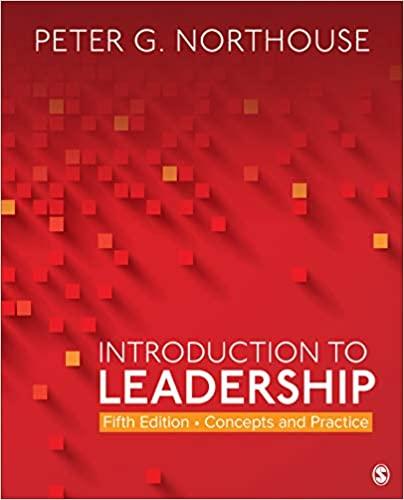Kristen Hadeed thought she had it made. As a college student, Kristen started cleaning houses to earn
Question:
Kristen Hadeed thought she had it made. As a college student, Kristen started cleaning houses to earn extra money. She soon found herself getting so many referrals she established her own business, Student Maid, with a business model of hiring only college students. Not long after, she landed a contract to clean hundreds of empty apartments at a large complex and hired 60 college students to help her.
However, on the second day of the big cleaning job, while she was lounging in the apartment complex’s air-conditioned clubhouse, 45 of her employees walked in and quit. Cleaning up after college students isn’t a fun job, and combined with the sweltering Florida summer heat and the air conditioning of the building they were working in being turned off, they’d had enough.
Thus began Kristen’s journey as a leader. Knowing she needed them to meet the obligations of the contract, she quickly moved to address the concerns of those who quit, meeting with them, admitting to her mistakes as a leader, and asking them what she could do to convince them to give her a second chance. She successfully convinced most to return, and she rolled up her sleeves and worked alongside them.
The experience made Kristen grasp that her biggest challenge was going to be sustaining a motivated, energized workforce in a field where employee turnover is 75%. Cleaning is not a glamorous business.
Seven days a week, Student Maid teams clean homes, offices, apartments, fraternity houses, and more. Cleaning up others’ messes can be disgusting, dirty work, not to mention physically hard. The average profit margin of a cleaning company is 15%, which means Student Maid could barely afford to pay its employees more than minimum wage (Hadeed, 2017). On top of this, Kristen realized she had created a difficult business plan: hiring only college students.
Class schedules were difficult to juggle, and around the time of spring break, many of her student employees would “call in sick.” In addition, at the end of a semester, she’d experience an exodus of students leaving as they graduated from school.
Kristen was determined to work through these challenges and to create a workplace and culture that her employees loved enough to put up with the serious downsides of the business. She wanted to become the company that no one ever wanted to quit. But by doing so, she created a whole new set of problems.
Kristen decided she needed to provide a supportive environment, becoming a cheerleader and problem solver for all her workers. She hired and trained every team member, lavishing praise and encouragement. She became “a helicopter boss”—whenever her students had a problem or dilemma, she swooped in to solve it. But when she made herself so available to the students, she found they didn’t think for themselves.............
Questions
1. Based on what you learned in Chapter 8, “Establishing a Constructive Climate,” how did the methods Student Maid leaders implemented create a constructive climate? How was that climate helpful in overcoming obstacles?
2. Which of the seven major obstacles derived from path–goal theory discussed in this chapter did the employees at Student Maid experience?
3. Describe how Kristen Hadeed used directive, supportive, participative, or achievement-oriented leadership to work through the challenges.
Step by Step Answer:

Introduction To Leadership Concepts And Practice
ISBN: 9781544351599
5th Edition
Authors: Peter G Northouse





